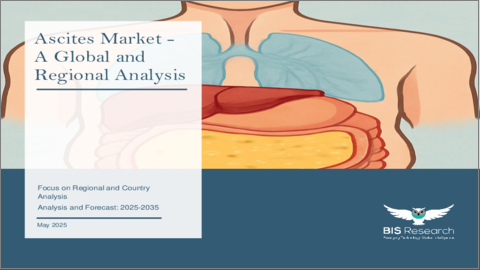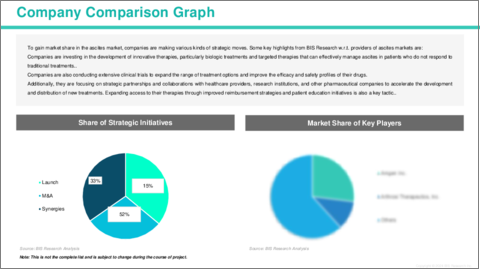|
|
市場調査レポート
商品コード
1735552
腹水の世界市場:地域・国別の分析・予測 (2025~2035年)Ascites Market - A Global and Regional Analysis: Focus on Regional and Country Analysis - Analysis and Forecast, 2025-2035 |
||||||
カスタマイズ可能
|
|||||||
| 腹水の世界市場:地域・国別の分析・予測 (2025~2035年) |
|
出版日: 2025年05月29日
発行: BIS Research
ページ情報: 英文 100 Pages
納期: 1~5営業日
|
- 全表示
- 概要
- 図表
- 目次
腹水市場は、さまざまな要因によって大きな成長を遂げています。
主な成長要因の一つは、肝硬変をはじめとする肝疾患や、肝臓がん、卵巣がん、膵臓がんなどのがんの罹患率が上昇していることです。これらの疾患はいずれも腹水の主要な原因であり、世界的にこれらの病気が増加していることが、診断ツールや治療オプションへの需要を高めています。生活習慣病、アルコール消費量、肝炎感染の増加もこの傾向に拍車をかけており、その結果、腹水市場の成長が促進されています。
さらに、超音波、CTスキャン、穿刺液の分析などの画像診断技術の進歩や改善も、市場成長の大きな要因です。早期発見と正確な診断が可能になることで、タイムリーな介入が可能になり、治療成績の向上につながります。非侵襲的かつ高感度な診断検査の普及は、腹水の早期診断の可能性を高め、それに伴って治療・管理の需要も拡大しています。
しかしながら、市場が成長を続ける一方で、いくつかの課題も存在しています。中でも最大の課題の一つは、肝移植、化学療法、新薬などの高度な治療法の治療費の高さです。特に発展途上国においては、医療インフラが整備されておらず、高額治療に対する保険の適用範囲が限られていることもあり、こうした費用が治療の大きな障壁となっています。このような経済的負担は、多くの患者にとって必要な治療へのアクセスを困難にし、市場の成長を制限する要因となっています。
さらに、治療による副作用や合併症が市場の成長をさらに抑制しています。利尿薬や腹腔穿刺を含む腹水処理のいくつかは、電解質不均衡、感染症、低血圧などの合併症や副作用を引き起こす可能性があります。こうした潜在的なリスクは、患者が治療を求めたり処方されたレジメンを遵守したりすることを躊躇させる可能性があり、その結果、これらの介入に対する全体的な需要が制限されることになります。さらに、腹腔穿刺を繰り返す必要性など、一部の治療には侵襲的な性質があるため、患者にとって不快であり、こうした選択肢を求める意欲を低下させる可能性があります。
当レポートでは、世界の腹水の市場を調査し、主要動向、市場影響因子の分析、法規制環境、臨床試験の動向、市場規模の推移・予測、各種区分・地域/主要国別の詳細分析、競合情勢、主要企業のプロファイルなどをまとめています。
目次
エグゼクティブサマリー
第1章 世界の腹水市場:業界展望
- 市場動向
- 規制の枠組み
- 腹水の疫学
- 臨床試験分析
- 市場力学
- 影響分析
- 市場促進要因
- 市場の課題
- 市場機会
第2章 世界の腹水市場:地域別
- 北米
- 欧州
- アジア太平洋
- 主な調査結果
- 市場力学
- 市場規模・予測
第3章 世界の腹水市場:競合情勢と企業プロファイル
- 主要な開発と戦略
- M&A
- 相乗的な取り組み
- 事業拡大と資金調達
- 製品の発売と承認
- その他
- 企業プロファイル
- Ocelot Bio
- PharmaIN
- Grifols Therapeutics LLC.
- Regeneron Pharmaceuticals.
- BioVie Inc
第4章 調査手法
List of Figures
- Figure: Global Ascites Market, Market Overview
- Figure: Epidemiology of Ascites
- Figure: Global Ascites Market Coverage
- Figure: Global Ascites Market Key Trends, Impact Analysis, 2023-2035
- Figure: Global Ascites Market, Competitive Landscape, January 2022-April 2025
List of Tables
- Table: Global Ascites Market, Clinical Trial Analysis,
- Table: Global Ascites Market Dynamics, Impact Analysis
- Table: Global Ascites Market (by Region), $Million, 2023-2035
Global Ascites Market, Analysis and Forecast: 2025-2035
Ascites is the abnormal accumulation of fluid in the peritoneal cavity, which is the space surrounding the organs in the abdomen. This condition can cause the abdomen to become distended or swollen and is often a sign of an underlying medical issue. It is typically associated with liver diseases, particularly cirrhosis, but can also result from cancer, heart failure, kidney disease, or infections.
The ascites market is witnessing substantial growth, driven by a range of key factors. One of the primary drivers for the ascites market is the rising prevalence of liver diseases, particularly cirrhosis, as well as various forms of cancer, such as liver, ovarian, and pancreatic cancer. As these diseases are among the leading causes of ascites, their increasing incidence globally is driving the demand for diagnostic tools and treatment options. The global rise in lifestyle diseases, alcohol consumption, and hepatitis infections has contributed to this increase, which in turn propels the growth of the ascites market.
Furthermore, the development and improvement of diagnostic technologies, including imaging techniques like ultrasound, CT scans, and the use of paracentesis for fluid analysis, are major drivers for the ascites market. Early detection and accurate diagnosis allow for timely intervention, improving treatment outcomes. The availability of non-invasive and highly sensitive diagnostic tests increases the likelihood of diagnosing ascites in its early stages, expanding the demand for related treatment and management options.
Despite the positive growth trajectory, several challenges continue to impact the global ascites market. One of the primary challenges is the high cost of treatments, particularly for advanced interventions such as liver transplants, chemotherapy, and some novel drug therapies. These costs can be a significant barrier to access, especially in developing regions where healthcare infrastructure may be limited, and insurance coverage for expensive treatments may not be available. This high cost can restrict the market growth, as many patients may not be able to afford the necessary care.
Moreover, side effects and complications of treatment further restrict the market growth. Several treatments for ascites, including diuretics and paracentesis, can lead to complications or side effects, such as electrolyte imbalances, infections, or low blood pressure. These potential risks may deter patients from seeking treatment or adhering to prescribed regimens, thus limiting the overall demand for these interventions. Additionally, the invasive nature of some treatments, such as the need for repeated paracentesis, can be uncomfortable for patients and may result in decreased willingness to pursue these options.
Leading players in the global ascites market, such as Ocelot Bio, Regeneron Pharmaceuticals, and BioVie Inc., are continuously focusing on several strategies to maintain their competitive edge and drive growth. These strategies include continuous technological innovation, such as the development of more advanced and efficient treatment options, mapping systems, and imaging technologies. These companies aim to enhance the safety and efficacy of ascites treatment options.
The competitive landscape of the global ascites market is diverse, with numerous players across different regions offering a wide range of products. Regional players and local manufacturers are expected to play an important role in the market's growth, especially as demand increases in emerging markets such as Asia-Pacific and Latin America. As consumer preferences shift towards more discreet, comfortable, and affordable solutions, the ascites market will continue to evolve, fostering new opportunities for both established and emerging companies.
As the ascites market continues to evolve, several emerging trends are expected to significantly influence its future trajectory. The aging global population is another significant factor driving the ascites market. Older adults are more prone to liver diseases, heart failure, and cancer, all of which are major risk factors for ascites. As the number of elderly individuals increases, the prevalence of ascites is expected to rise, further driving the demand for effective treatments and management strategies.
In conclusion, the global ascites market is expected to see steady growth, driven by the increasing prevalence of underlying conditions such as liver diseases and cancers, as well as advancements in diagnostic and therapeutic options. Continued research and innovation in targeted treatments, along with a growing focus on early detection, will be key to improving patient outcomes and reducing the burden of ascites on healthcare systems. As stakeholders, including pharmaceutical companies, healthcare providers, and researchers, continue to work toward better management strategies, the market will evolve to offer more effective solutions, ultimately enhancing the quality of life for patients and addressing the ongoing challenges posed by this condition.
Table of Contents
Executive Summary
Scope and Definition
Market/Product Definition
Inclusion and Exclusion
Key Questions Answered
Analysis and Forecast Note
1. Global Ascites Markets: Industry Outlook
- 1.1 Introduction
- 1.2 Market Trends
- 1.3 Regulatory Framework
- 1.4 Epidemiology of Ascites
- 1.5 Clinical Trial Analysis
- 1.6 Market Dynamics
- 1.6.1 Impact Analysis
- 1.6.2 Market Drivers
- 1.6.3 Market Challenges
- 1.6.4 Market Opportunities
2. Global Ascites Market, by Region, $Million, 2023-2035
- 2.1 North America
- 2.1.1 Key Findings
- 2.1.2 Market Dynamics
- 2.1.3 Market Sizing and Forecast
- 2.1.3.1 North America Ascites Market, by Country
- 2.1.3.1.1 U.S.
- 2.1.3.1 North America Ascites Market, by Country
- 2.2 Europe
- 2.2.1 Key Findings
- 2.2.2 Market Dynamics
- 2.2.3 Market Sizing and Forecast
- 2.2.3.1 Europe Ascites Market, by Country
- 2.2.3.1.1 Germany
- 2.2.3.1.2 U.K.
- 2.2.3.1.3 France
- 2.2.3.1.4 Italy
- 2.2.3.1.5 Spain
- 2.2.3.1 Europe Ascites Market, by Country
- 2.3 Asia Pacific
- 2.3.1 Key Findings
- 2.3.2 Market Dynamics
- 2.3.3 Market Sizing and Forecast
- 2.3.3.1 Asia Pacific Ascites Market, by Country
- 2.3.3.1.1 Japan
- 2.3.3.1 Asia Pacific Ascites Market, by Country
3. Global Ascites Market: Competitive Landscape and Company Profiles
- 3.1 Key Development and Strategies
- 3.1.1 Mergers and Acquisitions
- 3.1.2 Synergistic Activities
- 3.1.3 Business Expansions and Funding
- 3.1.4 Product Launches and Approvals
- 3.1.5 Other Activities
- 3.2 Company Profiles
- 3.2.1 Ocelot Bio
- 3.2.1.1 Overview
- 3.2.1.2 Top Products / Product Portfolio
- 3.2.1.3 Target Customers/End-Users
- 3.2.1.4 Key Personnel
- 3.2.1.5 Analyst View
- 3.2.2 PharmaIN
- 3.2.2.1 Overview
- 3.2.2.2 Top Products / Product Portfolio
- 3.2.2.3 Target Customers/End-Users
- 3.2.2.4 Key Personnel
- 3.2.2.5 Analyst View
- 3.2.3 Grifols Therapeutics LLC.
- 3.2.3.1 Overview
- 3.2.3.2 Top Products / Product Portfolio
- 3.2.3.3 Target Customers/End-Users
- 3.2.3.4 Key Personnel
- 3.2.3.5 Analyst View
- 3.2.4 Regeneron Pharmaceuticals.
- 3.2.4.1 Overview
- 3.2.4.2 Top Products / Product Portfolio
- 3.2.4.3 Target Customers/End-Users
- 3.2.4.4 Key Personnel
- 3.2.4.5 Analyst View
- 3.2.5 BioVie Inc
- 3.2.5.1 Overview
- 3.2.5.2 Top Products / Product Portfolio
- 3.2.5.3 Target Customers/End-Users
- 3.2.5.4 Key Personnel
- 3.2.5.5 Analyst View
- 3.2.1 Ocelot Bio






